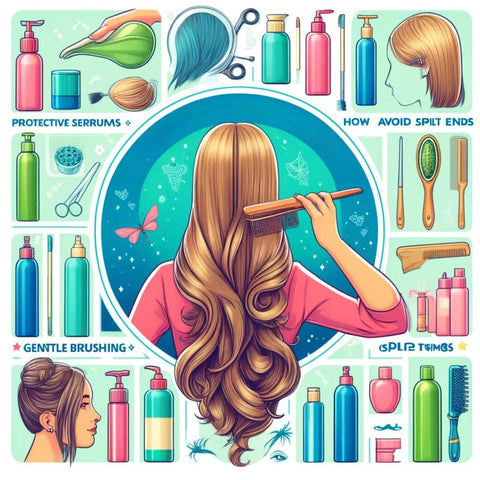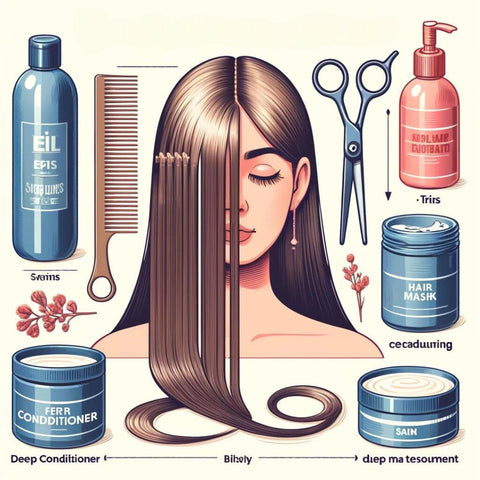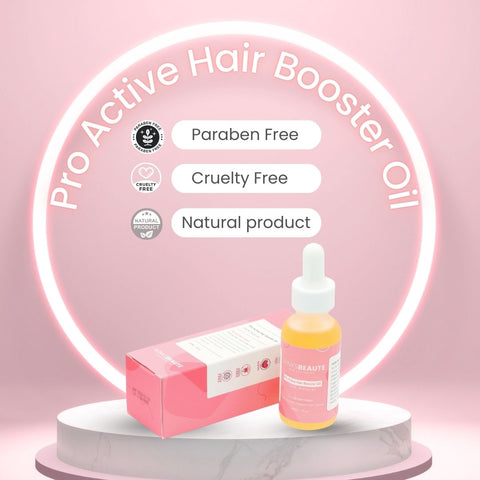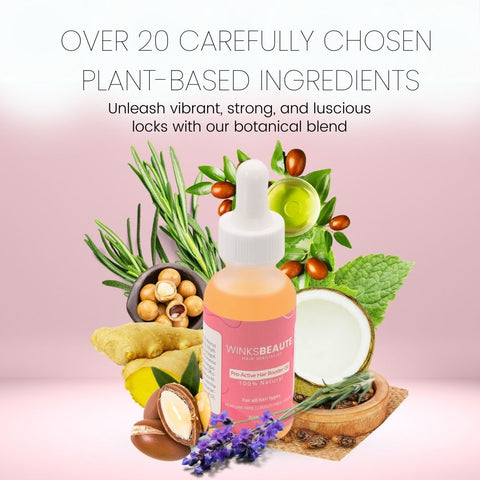
Why Do I Have So Many Split Ends? Secrets to Healthy Hair Unveiled
Share
Split ends signify your hair's need for attention and care. This in-depth guide is designed to equip you with the strategies to combat split ends, providing insights into their underlying causes and offering solutions to effectively combat them. By understanding how to combat split ends, you're set on a path toward maintaining resilient, vibrant hair. Implementing these methods not only helps combat split ends but also promotes overall hair health, ensuring your locks don't just appear visually appealing but are also fundamentally strong and nourished.

Introduction
Split ends, the bane of smooth, sleek hairstyles, often leave us wondering where we've gone wrong in our hair care routines. These unwelcome indicators of hair distress can detract from the beauty of your locks, making even the most carefully styled hair appear unkempt. Understanding the root causes of split ends and adopting effective preventive measures can transform your hair's health and appearance, leading to vibrant, strong strands.
Unraveling the Mystery of Split Ends
To effectively combat split ends, it's crucial to understand what they are and why they occur.
What Are Split Ends?
Split ends happen when the hair's protective outer layer, the cuticle, wears away due to various forms of damage. This wear and tear exposes the inner fibers of the hair shaft, leading to weakened strands that eventually split. Recognizing the structural makeup of hair and the process leading to split ends lays the groundwork for addressing them effectively.

The Main Culprits: What Causes Split Ends?
The journey to split ends is paved with a range of factors, from the environmental to the mechanical:
- Environmental Stressors: Exposure to the sun, wind, and dry climates can sap moisture from your hair, leaving it vulnerable to splitting.
- Mechanical Stress: Styling practices, including brushing wet hair too aggressively, using heat styling tools frequently, and tight hairstyles, contribute significantly to the formation of split ends.
- Chemical Treatments: Dyes, relaxers, and perms strip hair of its natural oils and weaken the cuticle, making split ends more likely.
- Nutritional Deficits: Just as the body needs nutrients to thrive, so does your hair. A lack of vital vitamins and minerals can lead to weaker hair prone to splitting.

Prevention is Key: How to Avoid Split Ends
Armed with an understanding of what causes split ends, you can now take proactive steps to prevent them.
Proper Hair Care Techniques
The foundation of split-end prevention is a hair care routine that minimizes damage:
- Washing and Conditioning: Use gentle, moisturizing products that replenish hair’s natural oils. Avoid washing your hair daily to prevent stripping it of its protective oils.
- Drying: Pat hair dry with a soft towel instead of rubbing it, and consider air-drying or using a low-heat setting on your hair dryer.
- Combing: Opt for a wide-tooth comb or a detangling brush designed to minimize pulling and breakage.
The Right Tools for the Job
Choosing the right tools is as crucial as the technique:
- Hair Ties: Avoid elastic bands that can snag and break the hair. Instead, look for soft, fabric-covered bands or spiral ties.
- Brushes and Combs: Invest in brushes with natural bristles and combs with smooth, wide teeth that gently detangle without causing damage.
Embracing these initial steps toward understanding and preventing split ends is just the beginning. As we delve further into nutrition, treatment, and product recommendations, including Proactive Rosemary Hair Booster Oil, we'll uncover more secrets to maintaining the health and beauty of your hair throughout menopause and beyond.
Nutrition and Hair Health
A balanced diet is crucial for nurturing strong, resilient hair capable of resisting the formation of split ends.
Foods That Promote Strong, Healthy Hair
Nutrient-rich foods play a vital role in hair health. Incorporating foods high in omega-3 fatty acids, vitamins A, C, E, and various B vitamins, along with minerals like zinc and iron, can significantly enhance hair strength and elasticity, mitigating the risk of split ends. Including salmon, nuts, eggs, spinach, and berries in your diet can contribute to healthier, more vibrant hair.
The Role of Hydration
Adequate hydration is essential for maintaining the overall health of your hair. Water facilitates the transport of nutrients to hair cells, promoting growth and vitality. Ensure you're drinking ample water throughout the day to keep your hair well-hydrated and less prone to splitting.

Treating Existing Split Ends
Addressing split ends after they've occurred is crucial for maintaining hair integrity.
Trimming: The First Line of Defense
Regular haircuts are the most effective method for removing split ends. Scheduling a trim every 6-8 weeks can help keep your hair healthy and prevent the further splitting of hair shafts.
Deep Conditioning and Hair Masks
Deep conditioning treatments and hair masks can provide temporary relief to split ends by sealing the hair cuticle and replenishing moisture. Opt for products enriched with natural oils and proteins to help strengthen the hair’s structure.
Spotlight on Proactive Rosemary Hair Booster Oil
Dedicated to the fight against split ends, Proactive Rosemary Hair Booster Oil stands out for its ability to nourish and strengthen hair.
Benefits of Proactive Rosemary Hair Booster Oil for Split Ends
Enriched with the natural goodness of rosemary oil, this product is designed to invigorate the scalp and promote healthier hair growth. Its nutrient-rich formula penetrates deep into the hair follicles, offering the moisture and strength needed to combat and prevent split ends.
Incorporating Proactive Rosemary Hair Booster Oil into Your Routine
Integrating this oil into your hair care routine can be a game-changer for preventing split ends. Apply it to the ends of your hair before bed to allow its conditioning properties to work overnight, or use it as a pre-shampoo treatment to safeguard your hair during washing.
Advanced Hair Care Tips
Beyond basic care, protecting your hair from environmental factors and minimizing styling damage are crucial steps in maintaining its health and preventing split ends.
Protecting Hair from Environmental Damage
Environmental elements like the sun, wind, and pollution can wreak havoc on your hair, exacerbating split ends and dryness. To shield your hair:
- Wear hats or scarves when outdoors to protect your hair from UV damage and dehydration.
- Use leave-in conditioners or hair serums that contain UV protectants.
- Rinse your hair with fresh water after swimming in chlorinated pools or salty seawater to prevent drying and damage.
Avoiding Heat Styling Damage
Heat styling tools are often necessary for achieving certain looks but can be detrimental to your hair's health:
- Limit the use of heat styling tools by embracing your hair's natural texture or experimenting with heat-free styling methods.
- Always apply a heat protectant spray before using heat on your hair to create a protective barrier.
- Opt for lower heat settings on devices to minimize damage and keep styling sessions brief.

The Psychological Impact of Split Ends
The condition of our hair can significantly affect our self-esteem and confidence, making the management of split ends more than just a matter of physical appearance.
Confidence and Hair Appearance
Healthy, well-maintained hair can be a source of confidence, while visible damage like split ends may affect how we view ourselves and interact with others. Recognizing this impact is key to understanding why investing time and care into our hair is worthwhile.
Embracing the Journey: Confidence Beyond Split Ends
Understanding and addressing the causes of split ends is essential, but so is embracing the natural changes your hair undergoes. Here's how to maintain confidence through your hair care journey:
- Regular Maintenance: Keep up with regular trims and deep conditioning treatments to minimize and manage split ends.
- Healthy Lifestyle Choices: Continue to support your hair health from the inside out with a balanced diet and adequate hydration.
- Professional Advice: Don't hesitate to seek guidance from hair care professionals for personalized care routines and treatments.
Conclusion: Transforming Challenges into Strength
Split ends are a common challenge, but they don't have to dictate the health and beauty of your hair. By understanding their causes, adopting preventive measures, and treating existing damage with the right products like Proactive Rosemary Hair Booster Oil, you can maintain strong, healthy hair. Remember, every strand tells a story of resilience and renewal—embrace it with confidence and pride.
Frequently Asked Questions
Can split ends lead to hair loss?
While split ends themselves don't cause hair loss, they can lead to hair breakage, making your hair appear thinner and shorter over time.
How often should I use Proactive Rosemary Hair Booster Oil?
For best results, apply the oil 2-3 times a week as part of your nighttime routine or use it as a pre-wash treatment.
Is it possible to permanently repair split ends?
While you can't permanently repair split ends once they've occurred, regular trims and proper hair care can prevent them from worsening and improve the overall appearance of your hair.
By embracing these strategies and incorporating the right products into your care routine, you can effectively manage split ends, ensuring your hair remains as vibrant and resilient as ever.
For a deeper dive into the connection between split ends and overall hair health, we invite you to explore further at Shocking Truth: Are Split Ends a Sign of Unhealthy Hair? Uncover more insights and tips to keep your hair at its best.

















